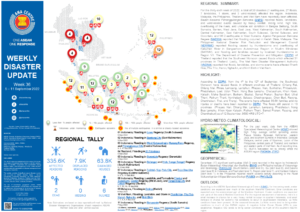
REGIONAL SUMMARY:
For the thirty-sixth week of 2022, a total of 39 disasters (1 earthquake, 27 floods, 7 landslides, 1 storm, and 3 wind-related) affected the region. Indonesia, Malaysia, the Philippines, Thailand, and Viet Nam have reportedly been affected. Badan Nasional Penanggulangan Bencana (BNPB) reported floods, landslides, and wind-related events caused by heavy rainfall, strong wind, high tide, overflowing of the rivers, and unstable soil condition in Bangka Belitung, South Sumatra, Banten, West Java, East Java, West Kalimantan, South Kalimantan, Central Kalimantan, East Kalimantan, South Sulawesi, Central Sulawesi, and Gorontalo, and M6.2 earthquake in West Sumatra. Agensi Pengurusan Bencana Negara (NADMA) reported that flooding occurred in Kedah State, Malaysia. The Philippines’ National Disaster Risk Reduction and Management Council (NDRRMC) reported flooding caused by thunderstorms and overflowing of Kabulhan River in Bangsamoro Autonomous Region in Muslim Mindanao (BARMM), and flooding and lanslides caused by localized thunderstorms in Region VII. The Department of Disaster Prevention and Mitigation (DDPM) of Thailand reported that the Southwest Monsoon caused floods which affected 31 provinces in Thailand. Lastly, The Viet Nam Disaster Management Authority (VNDMA) reported that floods, landslides, and storms events have affected Thanh Hoa, Phu Tho, Hanoi, Nghe An, and Ninh Binh in Viet Nam.
HIGHLIGHT:
According to DDPM, from the 4th to the 12th of September, the Southwest Monsoon have caused floods in different provinces of Thailand (Chiang Rai, Chiang Mai, Phrae, Lampang, Lamphun, Phayao, Nan, Sukhothai, Phitsanulok, Phetchabun, Loei, Udon Thani, Nong Bua Lamphu, Chaiyaphum, Khon Kaen, Kalasin, Maha Sarakham, Buriram, Sisaket, Samut Prakan, Suphan Buri, Uthai Thani, Pathum Thani, Nonthaburi, Sakaeo, Chachoengsao, Chon Buri, Rayong, Chanthaburi, Trat, and Trang). The events have affected 56.5K families and no injuries or deaths have been reported by DDPM. The floods still persist in 13 provinces (Phayao, Nan, Chiang Mai, Lamphun, Lampang, Phetchabun, Nong Bua Lamphu, Khon Kaen Kalasin, Pathum Thani, Samut Prakan, Rayong, and Chanthaburi) as of 12 September, 0600 HRS UTC+7.
HYDRO-METEO-CLIMATOLOGICAL:
For the past week, data from the ASEAN Specialised Meteorological Centre (ASMC) showed high 7-day average rainfall spreading across Papua, Maluku, Sulawesi, Kalimantan, western Java, and southern Sumatra in Indonesia; Sarawak Malaysia; central parts of Myanmar; Luzon of the Philippines; central parts of Thailand; and northern and eastern parts of Viet Nam. As of reporting time, TC MUIFA forecasted not to directly affect the ASEAN region (PAGASA, JTWC).
GEOPHYSICAL:
Seventeen (17) significant earthquakes (M>5.0) were recorded in the region by Indonesia’s Badan Meteorologi, Klimatologi, dan Geofisika (BMKG) and Philippine Institute of Volcanology and Seismology (PHIVOLCS). Mount Semeru (alert level III), Ibu (alert level II), and Dukono (alert level II) in Indonesia, and Taal (alert level 1), Mayon (alert level 1), and Kanlaon Volcano (alert level 1) in the Philippines reported recent volcanic activity according to the Pusat Vulkanologi dan Mitigasi Bencana Geologi (PVMBG) and PHIVOLCS.
OUTLOOK:
According to the ASEAN Specialised Meteorological Centre (ASMC), for the coming week, wetter conditions are expected over much of the southern Maritime Continent. Drier conditions are expected over the westernmost part of the Maritime Continent. Cooler conditions are expected over parts of the central Maritime Continent. For the regional assessment of extremes, there is a small increase in chance for a very heavy rainfall to occur in southern Indonesia; and small increase in chance for extreme hot conditions to occur in southeastern Indonesia. La Niña conditions have been present. At the seasonal timescale, La Niña events tend to bring wetter conditions to much of the ASEAN region. A negative Indian Ocean Dipole (IOD) is now established. Negative IOD tends to bring wetter conditions to much of the southern ASEAN region.
Sources:
ASEAN Disaster Monitoring & Response System (DMRS); ASEAN Specialised Meteorological Centre (ASMC); Joint Typhoon Warning Centre (JTWC);
Indonesia: BNPB, BMKG, PVMBG;
Malaysia: NADMA;
Philippines: NDRRMC, PAGASA, PHIVOLCS;
Thailand: DDPM;
Viet Nam: VNDMA;
Various news agencies.







